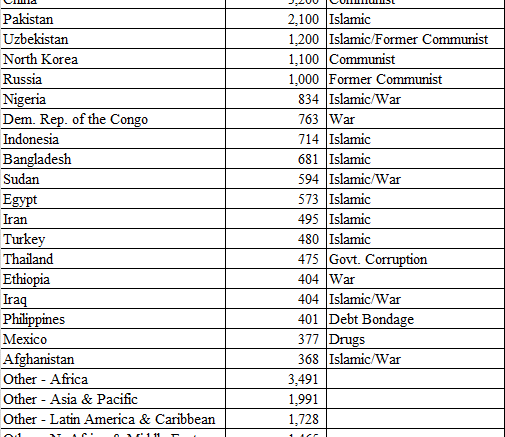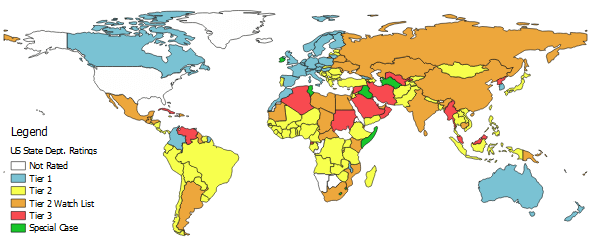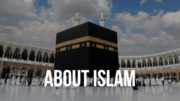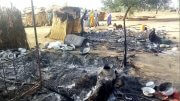Dan Wolf
This site normally looks at issues relevant to Islam; its history, cultural attitudes, etc.
Today’s topic is modern slavery, an issue that goes well beyond Islam.
It is a problem that is global in scope. Although it is more prevalent in countries that govern using collectivism (such as communism, fascism, Islam, nationalism, progressivism, or socialism), it is also present in countries with republican forms of governance – such as the U.S. In all cases it represents a form of moral corruption, as discussed below. There are, however, a couple of ties that add to slavery’s prevalence within Islamic countries.
First, slavery is permissible under Islam. This item is a hold-over from pre-Islamic Arab culture. The second tie relates to jihad. There is a breakdown in governance and law during any period of war. Within Islamic jihad, captives can either be made slaves or held for ransom. Captives were historically part of the booty received by those who fought. One example, the first war fought by the U.S. was against the Barbary Pirates of North Africa, who raided ships and took captives that were made slaves or held for ransom. While this example is more recent, it is behavior going back to the actions sanctioned by Muhammad’s example in the seventh century.
Factors Underlying Modern Slavery
Modern slavery in most countries is driven by one or more of the following factors:
- Drug trade
- Forced labor
- Sex trafficking
The drug trade uses slaves as forced labor not only to grow and process drugs, but in smuggling them as well. Slaves are often used in menial labor intensive industries such as agriculture, construction, domestic servitude, factories, mining, and textiles. In some countries children and others are forced into organized begging. Sex trafficking not only includes forced prostitution, but in some countries supplying women for the temporary marriages allowed by Islam. Some countries serve primarily as a source of slaves, others as their destination, and still others facilitate their movement between countries. One typical pattern is people in countries with few jobs volunteering to work in other countries. Once they arrive in the country they are to work in, their wages are withheld and/or their passports are taken by the person who paid to bring them. They become illegal migrant workers with few rights and no legal standing. They are often put into forced labor situations or prostitution with no/little recourse to address their forced servitude.
The Data
There are about 195 countries recognized in the world today. Estimates for the Islamic population within almost all of those countries is available, and estimates of the slave population are available for about 165. Additionally, the most recent U.S. State Dept. report on human trafficking reviews and rates almost 150 of these countries. Estimates for the top ten slave countries in this article come from Wall St 24/7, and figures for the remaining countries come from The Global Slavery Index. Country ratings come from the 2007 and 2016 U.S. State Dept. Trafficking in Persons Reports.
The Global Slave Population
Slave populations are difficult to estimate, but the figures run between 30 and 45 million people world-wide. Most of the slave population is concentrated in just a few countries. The figures used in this article put the slave population at about 40 million. Almost 65% of those reside within ten countries, and a total of about 75% in the top twenty. A list of the 20 countries with the largest slave populations, and the remaining slave population by region, is shown below.

Relatively few factors underlie slavery in the above table. There is a single commonality across all these factors. It is refusing to acknowledge the equality of nature given to us by our Creator, and based on our common ancestry. I believe the factors mentioned above are a natural result of the elitism that underlies all collectivist societies, regardless of the ‘ism’ they are derived from. Once you cut yourself loose from the truth, you can rationalize going just about anywhere. This is the first rule of Saul Alinsky’s discussion of ends and means. ‘One’s concern with the ethics of means and ends varies inversely with ones personal interest in the issue.’ This is to say that the more you care about an issue the less you should care about the morality of the means used to combat it. From a Christian perspective, this teaching is false as the ends and means used to obtain them both matter. Robbing someone in order to give to a charity is an immoral act – it is evil. Period.
Some societies, such as communist countries, are built upon atheism. Others recognize an ideology (Islam) where men are placed above women, and Muslims above non-Muslims. These views are institutionalized through the legal system and rights that some individuals have – but others do not. Equality under the law as it is to exist in Western countries is not recognized. India’s caste system represents another institutionalized form of elitism based upon your parents societal position.
Slave Population Distribution
Augustine believed that war occurs when men are turned to themselves and not toward their Creator, and war is present across much of Africa and Asia today. War disrupts society and its institutions, leaving people vulnerable to mistreatment and enslavement. Underlying much of the conflict in Africa is the spread of Islam by armed forces such as Boko Haram and Al-Shabaab, and attempts to implement a particular type of Islamic ideology by groups such as Al-Qaeda, ISIS, and Ansar al-Sharia. Drugs, government corruption, and debt bondage round out the list. These last items also point to a basic undermining of morality and placing self-interest above self-sacrifice.
While the raw number of slaves within a country matters, this measure alone does not provide the full picture. The percentage of the total population that is in slavery also matters. A large country may have many slaves, but they may be a very small part of the overall population (China), or a small country may have relatively few slaves, but it represents a large part of the population (Mauritania). The following graph takes these relationships into account. It should be noted that for this and the remaining graphs, full information for the Republic of South Sudan is not available as it has recently formed. Where figures for this country are available, they have been added to those of the Sudan from which it separated.

Regarding the above graph, as the slave population within a country increases the country becomes pinker. As slaves make up a greater percentage of the total population, the shading becomes greener. As both increase together the country’s shading becomes first blue and then deep purple. Slavery occurs to a greater extent within Africa and South Asia, particularly in an arc from The Democratic Republic of the Congo in central Africa, through Egypt, and on into India.
The breakdown of the 177 countries into the categories indicated in the legend above are:

There were also 19 countries in the map which had no slave data. With the exception of South Sudan, the other countries were island nations or disputed territories – many of which are too small to be visible.
We mentioned earlier that conflict is greatest today across much of Africa and in Asia. This includes North Africa and the Middle East. The remainder of this article will look at the impacts of war on slavery, and the country ratings on human trafficking as provided by the U.S. State Department. The latter provides some subjective measure of a government’s responsiveness to the problem.
Islam and War
Jihad represents an institutionalized form of war within Islam, and war leaves people more vulnerable to being taken into slavery. The map below shows conflict areas overlaid upon the degree to which a country is Islamic, as measured by the percentage of the population that follows Islam. The war figures come from Wikipedia and represent the countries involved in various conflicts classified by the number of deaths occurring annually.
- Major War – 10,000 or more deaths within the past year
- War – 1,000 to 9,999 deaths within that same period
- Minor Conflict – 100 to 999 deaths within the past year
- Skirmishes – less than 100 deaths within the past year
The country population figures come from the CIA handbook and Pew Research Forum.
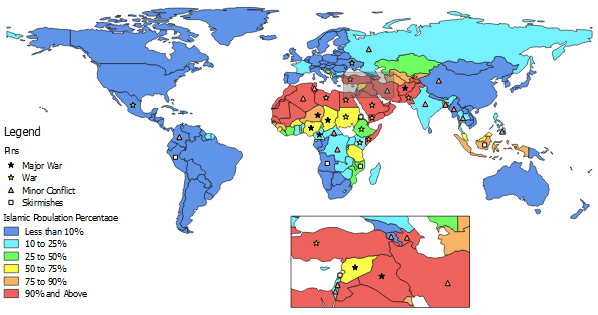
There is a high degree of correlation between the degree to which a country is Islamic and level of conflict that is present. This is consistent with the results in the last section as most countries across North Africa and the Middle East have a relatively higher percentage of their population as slaves and their number is relatively greater.
The conflict within this area generally takes one of two forms.
- Spread of Islam to non-Islamic countries. This includes the fighting within: (1) Nigeria that has spread into Cameroon, Niger, and Chad, (2) Sudan, (3) South Sudan and Ethiopia, (4) Kenya and Somalia, and (5) Israel and the West Bank/Gaza.
- The attempt to implement more fundamentalist Islamic principles within existing Islamic societies. This includes: (1) insurrections within Algeria, Tunisia, Libya, Egypt, Afghanistan, and Pakistan (2) fighting between Saudi Arabia and Iran backed groups in Yemen, (3) Syria and Iraqi factions backed by Iran, Russia, and the U.S.
War Increases Instability and the Risk of Slavery
So far we’ve looked at information about slave population and the presence of conflict in those locations, but what about government’s efforts to combat it? For some measure we turn to the State Department’s annual Human Trafficking Reports. Two years will be used as any information produced by the current administration must be taken with some degree of skepticism. It has repeatedly shown it is willing to go to any lengths to sell its narrative, but even this information shows that the world is a less safe place today.
The following categories are used in these reports.
- Tier 1 – Fully complies with the Trafficking Victims Protection Act’s minimum requirements.
- Tier 2 – Country does not fully comply with the above Act, but is making significant progress.
- Tier 2 Watch List – The same as Tier 2 and either (1) the number of victims are significantly increasing, (2) evidence is not provided of increased efforts to combat human trafficking, or (3) the country has made significant commitments to take steps in the next year.
- Tier 3 Countries that do not comply with the Act’s minimum standards, and are not making significant efforts to do so.
- Special Case – Instances where there is not enough information to categorize a country.
The first map is from 2007. In this year the country tier placements are as follows.
![]()
Figure 1: 2007 U.S. State Department Ratings
Ten of the sixteen Tier 3 countries were in North Africa, the Middle East, or Central Asia. Only Morocco (and the West Sahara) is listed as a Tier 1 country within this same region. We can also see that the problem is more widespread than just these areas, as much of Asia and South America are rated as Tier 2 or higher. Most governments in these area tend to be more collectivist, and many appear in the top 20 list shown earlier. The same information for 2016 is shown below. There were eighteen additional countries evaluated in 2016.
![]()
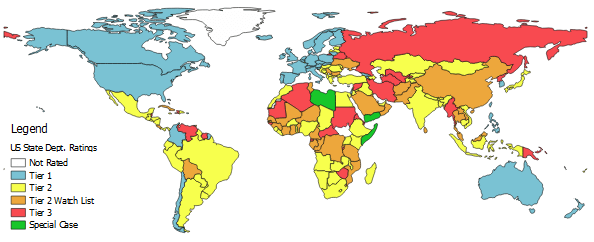
Figure 2: 2016 U.S. State Department Ratings
There are no Tier 1 countries in Africa, the Middle East, Central or South Asia. Twelve of the twenty seven Tier 3 countries are Islam majority countries, and all three special cases are Islam majority countries in Africa or the Middle East where conflict is present. One final analysis. I gave each country that was ranked in both years the following values.
- Tier 1 – 1
- Tier 2 – 2
- Tier 2 Watch List – 3
- Tier 3 – 4
Countries that either were not ranked in one year or were considered special cases were excluded. I then took the difference in rankings between the two reports. The results are:

From both the conflict information and the above human trafficking rankings, the world appears to be more at risk today. Historically greater insecurity has translated into an increase in slavery. I pray that does not occur, but the trends during these last eight years has not been good.
One final word. In the West slavery does exist, but its perpetrators are criminals who should be identified and prosecuted. In many other parts of the world, it is accepted as a part of society – regardless of its government’s stated position. I pray too that this will change. But it will only happen when a people turns away from itself and to its Creator. Only then will human life be given its proper value as brothers and sisters and not objects.

